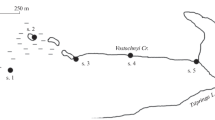Abstract
High molecular weight DOM (apparent mol wt. ≥1500) was isolated from lake water, both in summer and in winter. Sephadex G-15 gel permeation chromatography with 0.02 M phosphate buffer yielded one peak. Elution with distilled water gave rise to distinct smaller sized subfractions. It was concluded that these compounds are weakly bound subunits of the macromolecules, which are liberated on elution with distilled water. The macromolecules were not stable in the dark. Exposing them to daylight in the laboratory and to sunlight, in quartz bottles enhanced conversion. During 6 weeks' exposure to weakly photolytic conditions (daylight >300 nm), organic carbon of the high molecular bulk substances decreased by 15% (winter) and by 25% (summer), while the concentrations of the apparent low molecular weight substances increased accordingly. Such a slow but continuous transformation may reduce also the <in situ> persistence of the macromolecules gradually.
Similar content being viewed by others
References
Allen, M. M. 1968. Simple conditions for growth of unicellular blue-green algae on plates.—J. Phycol.4: 1–4.
Determann, H. 1967. Gelchromatographie.—Springer Verlag, Berlin, Heidelberg, New York.
Gardner, W. S., and P. F. Landrum. 1983. Characterization of ambient levels of ultraviolet-absorbing dissolved humic materials in natural waters by aqueous liquid chromatography.—in: aquatic and terrestrial humic materials. Christman, R. F. and E. T. Gjessing (eds).—Ann Arbor Science. The Butterworth group: 203–217.
Geller, A. 1986. Comparison of mechanisms enhancing biodegradability of refractory lake water constituents. —Limnol. Oceanogr. (in press).
Geller, A. 1985. Degradation and formation of refractory DOM by bacteria during simultaneous growth on labile substrates and persistent lake water constituents.—Schweiz. Z. Hydrol.47: 27–44.
Gloor, R., H. Leidner, K. Wuhrmann and T. H. Fleischmann. 1981. Exclusion chromatography with carbon detection. A tool for further characterization of dissolved organic carbon.—Water Res.15: 457–462.
Hine, P. T., and D. B. Bursill. 1984. Gel permeation chromatography of humic acid: problems associated with Sephadex gel.—Water Res.18: 1461–1465.
Hobson, L. A. and F. A. Hartley. 1983. Ultraviolet irradiance and primary production in a Vancouver island fjord, British Columbia, Canada.—J: Plankt. Res.5: 325–331.
Il'In, N. P., and D. S. Orlov. 1973. Photochemical destruction of humic acids.—Soviet Soil Sci.13: 75–83.
Kramer, C. J. 1979. Degradation by sunlight of dissolved fluorescing substances in the upper layers of the eastern Atlantic Ocean.—Neth. J. Sea Res.13: 325–329.
Plechanov, N. 1983. Studies of molecular weight distributions of fulvic and humic acids by gel permeation chromatography. Examination of the solute molecular composition using RI, UV, fluorescence and weight measurement as detection techniques.—Org. Geochem.5: 143–149.
Schnitzer, M. 1978. Some observations on the chemistry of humic substances.—Agrochimica22: 216–225.
Steinberg, Ch., and U. Münster. 1985. Geochemistry and ecological role of humic substances in lake water.—in: humic substances in soil, sediment and water. Eds. John Wiley: 105–146.
Stewart, A. J., and R. G. Wetzel. 1981. Dissolved humic materials: photodegradation, sediment effects, and reactivity with phosphate and calcium carbonate precipitation.—Arch. Hydrobiol.92: 265–286.
Strome, D. J., and M. C. Miller. 1978. Photolytic changes in dissolved humic substances.—Verh. Internat. Verein. Limnol.20(2): 1248–1254.
Urano, K., K. Katagiri, and K. Kawamoto. 1980. Characteristics of gel chromatography using Sephadex gel for fractionation of soluble organic pollutans.—Water Res.14: 741–745.
Wetzel, R. G. 1983. Limnology.—2nd Ed., Saunders, Company Philadelphia, London, Toronto.
Author information
Authors and Affiliations
Rights and permissions
About this article
Cite this article
Geller, A. Light-induced conversion of refractory, high molecular weight lake water constituents. Schweiz. Z. Hydrol 47, 21–26 (1985). https://doi.org/10.1007/BF02538181
Received:
Issue Date:
DOI: https://doi.org/10.1007/BF02538181




